Libraries + Archives History
History of the William Allen White Library
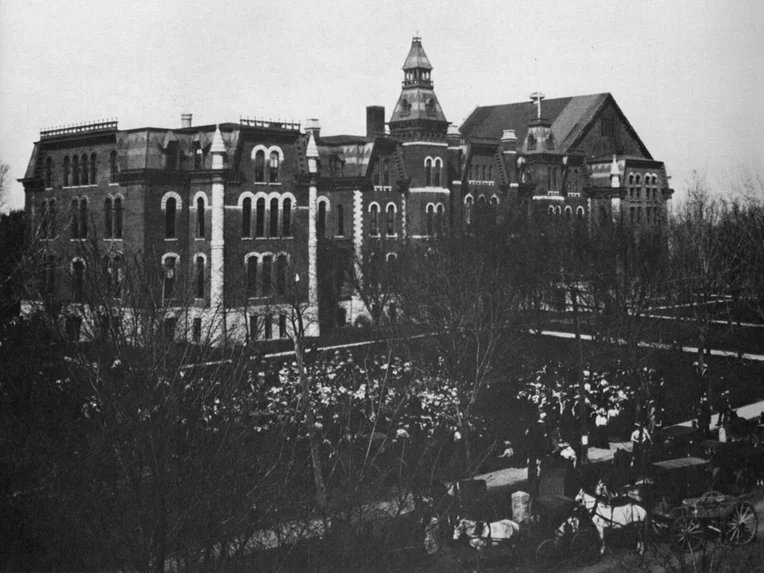
Note: We are indebted to several sources written about the evolution of what is now William Allen White Library. These sources are listed at the end of this history.
The history of William Allen White Library truly reflects the statement, “The more things change, the more they remain the same.” Since March 3, 1863 when the present Emporia State University was established as the Kansas State Normal School by the Kansas Legislature, the need for a library to meet the teaching and learning needs of faculty and students has always been a primary focus. February 15, 1865 saw the first term of instruction begin for the Kansas State Normal School in a stone building at the corner of Seventh Avenue and Constitution Street (Stephens 1).
To view our library history through the years, flip through the image carousel below:
Library history through the years
-
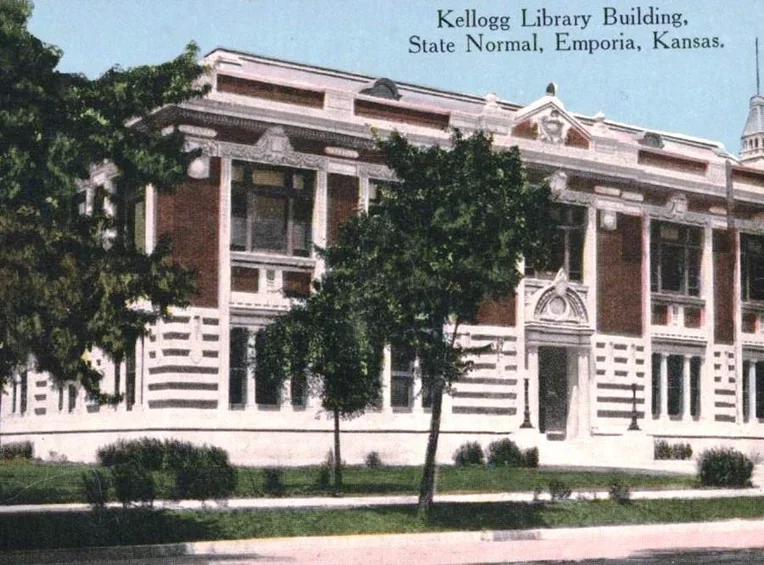
Image of the Kansas State Normal School building
KSN and Kellogg Library, 1865-1950
That first day of class was conducted by then-Principal Lyman B. Kellogg for 18 students; Kellogg later served as KSN President from 1865 to 1871 (Stephens 1; Former Presidents). Kellogg’s Bible, which is now held in the Emporia State University Archives, and a Webster’s dictionary were the first two books of a KSN library. This situation was quickly remedied by the end of 1865 by the additions of “reference and reading tables, on which are found books for consultation and the leading newspapers of the State” (Stephens 3).
From 1867 until 1903, the library without a formal name was housed in rooms in the KSN main building on the present-day Emporia State University campus. However, by 1900 over 15,000 library volumes filled up four rooms and the space was no longer adequate for a growing student enrollment. President Albert R. Taylor wrote in his 1900 report to the Kansas Board of Regents that “the time has come when we should house our present valuable library in a fireproof building and prove the additional room demanded for the other books so urgently needed, and for the accommodations of the students who may be using them” (Stephens 15). The state legislature listened, and in 1901 appropriated $60,000 to construct a building that would become Kellogg Library (Stephens 15). -
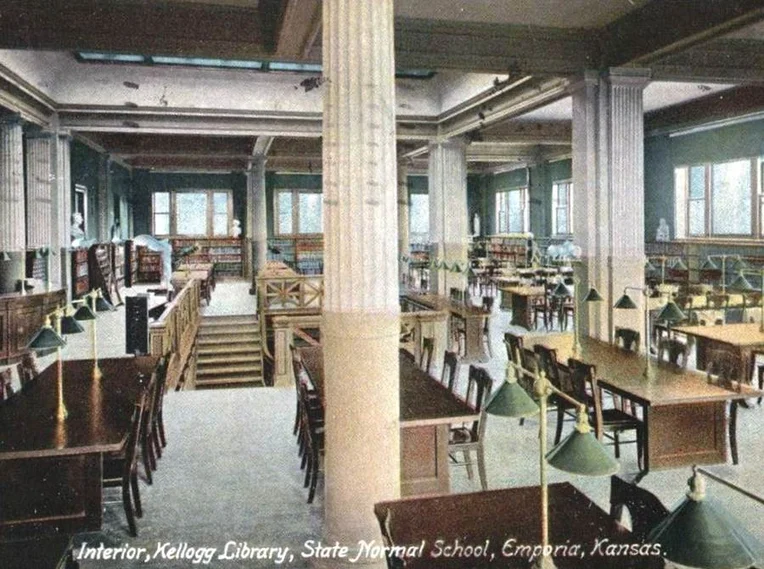
Image of the inside of Kellogg Library
KSN and Kellogg Library, 1865-1950
Dedication ceremonies were held in November 1903 for the two-story structure of brick and terra cotta, the second building on the KSN campus. Kellogg Library was named in honor of the school’s first president, Lyman B. Kellogg, who had brought those two books in 1865 as the foundation of many information resources to come.
The Kellogg Library building was impressive particularly for its day! Over the next few decades, it addressed the information and research needs for students. The school’s name in turn underwent a name and focus change; Kansas State Normal was primarily a teacher training school, while the name of Kansas State Teachers College of Emporia reflected a liberal arts college. In 1909, the library became a selective United States government documents depository along with State of Kansas documents. Related to Kellogg Library services, a high school library was established in 1923 on the 4th floor of Plumb Hall and “equipped as a demonstration of the possibilities of a model high school library” (Stephens 19). And, in a neat innovation before office telephones, speaking tubes were installed in 1928-29 throughout library offices “to facilitate speed and ease in communication and in service” (Stephens 19).
However, the same fortuitous situation – growth in student enrollment and increased needs for study space and books – eventually faced Kellogg Library. By 1935, the library’s print collection had grown to nearly 70,000 volumes in a building with the capacity of only 35,000 volumes(Stephens 88). -
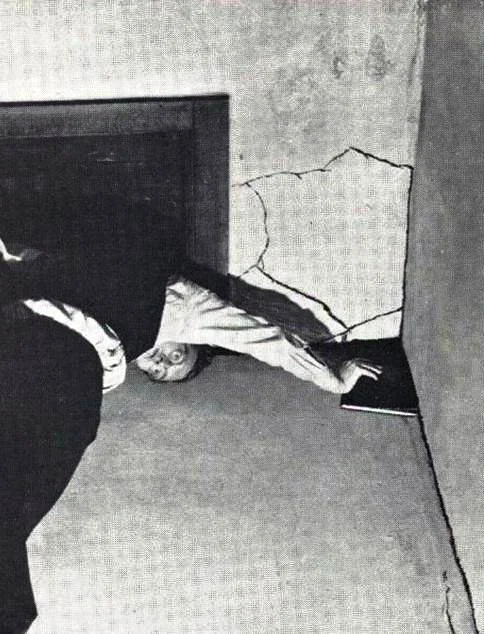
Image of a library patron holding a book.
William Allen White Library, 1950-present
The outcry for a new library building lasted a long time! Marjorie Gilson Williams notes that articles and reports from the 1930s to the end of World War II continuously pointed out the deterioration of Kellogg Library. It was possible, for instance, to push a book through a crack where the wall and ceiling joined together. Additional cracks allowed water to leak on books (Williams, 1, chap. III). The need for a new library was emphasized to the Kansas Legislature throughout the 1930s and 1940s, and on March 17, 1944 the name for the proposed library building was voted upon by the Kansas Board of Regents: William Allen White Library (Williams, 1, chap. IV). This name honors William Allen White, editor of the Emporia Gazette from 1896 to his death in 1944 and an influential figure nationally in journalism and politics.
Due to material and financial constraints during the Second World War and after, contracts for the new library building did not become a reality until December 1949. The official groundbreaking ceremony took place on February 6, 1950; a cornerstone for the library was laid on October 30, 1950; and the building itself was completed and ready for inspection by the State Architect on November 20, 1951 (Williams, 14-15, chap. IV). -
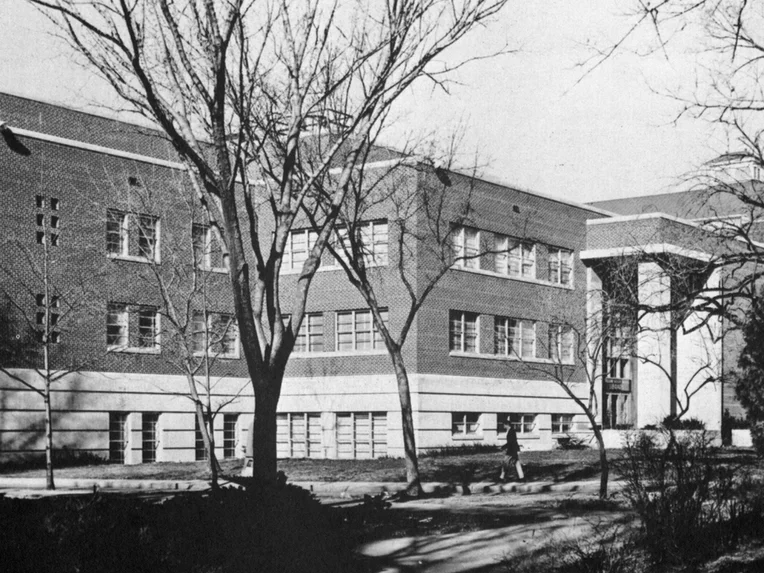
Image of the side of the William Allen White Library building.
William Allen White Library, 1950-present
The new building had overall dimensions of 138 x 142 feet. It was able to seat 700 persons and the book capacity provided space for over 300,000 volumes. The William Allen White Memorial Recreational Reading Lounge on the 2nd floor was equipped with a fireplace, comfortable living-room furniture and displays of books by and about William Allen White. The building also housed offices for the Graduate Division and the School of Library Science, now the School of Library and Information Management (Williams, 18, chap. IV).
It is fascinating in our current time of immediately accessible full-text resources online to review the process in the 1950s and 1960s to obtain books and articles from the library. Faculty and students alike were required to “surrender their identification cards in order to enter the stacks to search for books and materials” (Mason 10). The frustration with this procedure was expressed in 1966 by one student in the Bulletin who “compared the process of getting into the library and the checking out of a book…to the entering of Morse Hall, the women’s dormitory, and the signing out of a girl for a social engagement” (Mason 11). Clearly, the concept of a library as a warehouse of protected information had changed and it was time for the William Allen White Library building to adapt accordingly. -
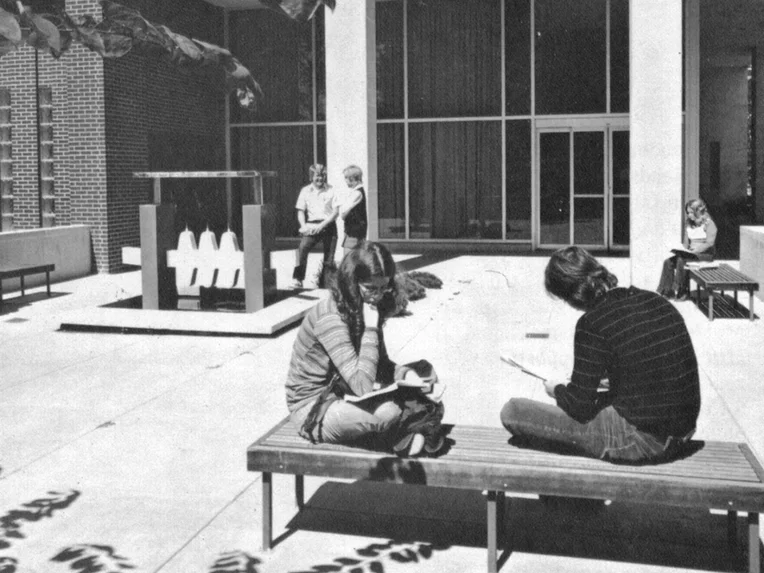
Image of students hanging out on the patio near the front of the library as they are reading books.
William Allen White Library, 1950-present
In the winter of 1969, construction began for an addition to the 1950 building. This addition added four floors to the north of the 1950 structure. It was completed and made ready for operations in March 1971, with one significant impact being the newly opened stacks that could be browsed freely by faculty, students, and staff.
Another change of the 1971 update was a reorganization of collections into subject divisions to focus services at that time upon specialized disciplines. Science and Technology materials were on the 1st floor, General Reference and Government Documents on the 2nd floor, Social Sciences on the 3rdfloor, and Humanities on the 4th floor. This organization remained the same until 1981, when Library Director George Hodowanec noted that “[s]taff shortage and lack of a central location” had led library staff to plan a consolidation of the divisions into one integrated book collection (Annual Report 1980/81 15-16). Amazingly, this move was accomplished by staff and student assistants during a library closing in a mid-year interim. The library building was reopened on January 22, 1982 with a focus upon Periodicals on the 1st floor and Reference on the 2nd floor as the two service points (Summary n.p.). -
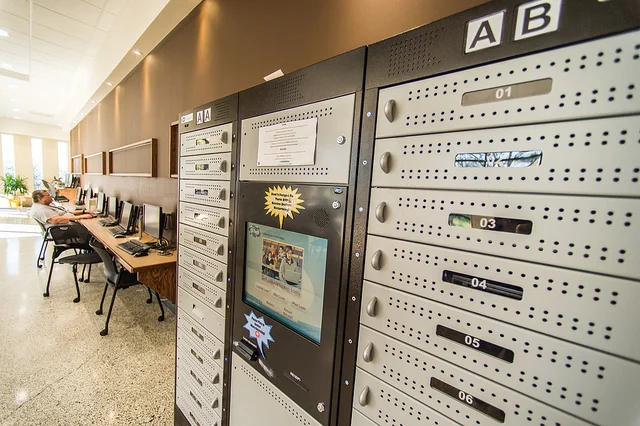
Image of the laptop kiosk located in the Learning Commons of the library.
William Allen White Library, 1950-present
Going toward the 1990s and into the present, a number of renovations to the physical interior of the library building and subsequent updates to rapidly changing information technologies have reinvented the 1950s and 1970s structures. The initial Library Electronic Classroom on the 2nd floor, which now houses the Writing Center, was constructed in 1996 as a recognition that library faculty roles were becoming increasingly teaching-focused. Students were discovering the concept of “information literacy” – accessing, using, and evaluating information as well as creating new knowledge for lifelong learning. A new Library Electronic Classroom in the southeast corner of the 2nd floor was built in 2010 and is in almost-constant use during the academic year for individual library instruction sessions, workshops, and the library’s undergraduate general education course titled UL100: Research Skills, Information, and Technology. -
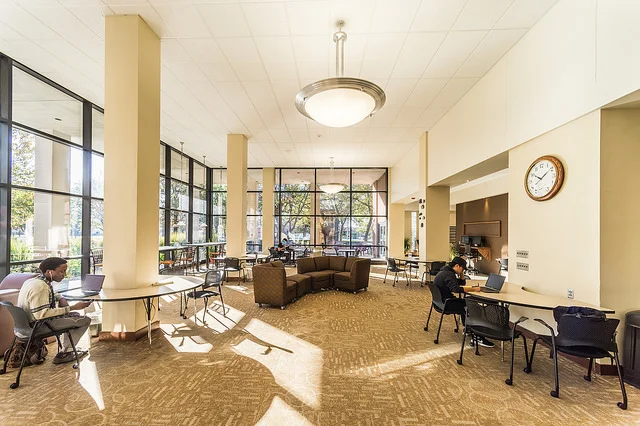
Image of the Library Learning Commons after recent renovations in 2013.
William Allen White Library, 1950-present
The library’s most recent noteworthy re-visioning of physical space is the Learning Commons. The university’s Associated Student Government, representing the voice of ESU students, expressed in 2011/12 an overall desire for additional individual and group research spaces in the library building. Circulation statistics of laptop computers checked out, “gate counts” of individuals entering and leaving the library, and general observations provided additional evidence that students were indeed utilizing the library for an educational and social gathering place. The former Circulation, Reserves, and Interlibrary Loan departments in the library lobby were combined in the summer of 2013 with the Information and Instructional Services department to create a central services desk on the 2ndfloor. In turn, the lobby was transformed in summer and early fall 2013 into an open, bright Learning Commons area equipped with computers, flat screens, and movable furniture and dividers to encourage collaborative study. The Learning Commons was originally open 24 hours a day, 5 days a week in Fall 2013. Positive student feedback, though, led to the area now being open 24/7. -
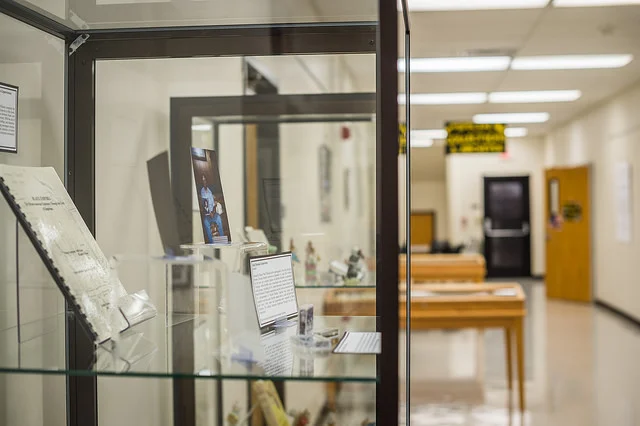
Image of a glass exhibit case located in the Special Collections and Archives exhibit hall.
William Allen White Library, 1950-present
The William Allen White Library building is also the home of Special Collections and Archives. Hence, the official name of our department is “University Libraries and Archives”. This area is mainly housed on the 1st floor of the library. The Archives serve as “the repository for records and artifacts of permanent, historical value produced or received by Emporia State University that pertain to its development and functions and/or represent it in its regional, national and global context” (Special Collections). One of its most unique offerings is the May Massee Collection. Established in 1971, it represents a wide variety of primary sources related to the work of May Massee as an influential children’s book editor at Doubleday and Viking Press. The collection is a major resource for research on children’s literature and among its artifacts are the original drawings for Robert McClosky’s classic children’s book, Make Way for Ducklings. Massee’s office from the Viking Press building was taken apart and painstakingly reassembled on the 3rd floor of the library building, where it can be viewed behind a glass window and is open by appointment.
The library is also the home for the William Allen White Children's Book Award. -
Image shows the 4th Floor of the library during its remodeling in 2017. In the corner are boxes for construction.
To the Future -- and Beyond!
We began this history with an observation that “the more things change, the more they remain the same”. A comment from the first years of the William Allen White Library captures our current vision as we look toward new information technologies and learning communities with an ever-changing student clientele:
As an institutional library, the resources of the William Allen White Library contribute to the specialized objectives of the college and its departments; but above and beyond any specialization, it shares with libraries in general the responsibility of providing information upon both sides of controversial issues, teaching its patrons how to find this information, and how they may arrive as nearly as possible at the truth (Rich n.p.).
Whatever the library of the future may be, we reaffirm the commitment to a welcoming, inviting discovery environment for Emporia State University faculty and students everywhere. -
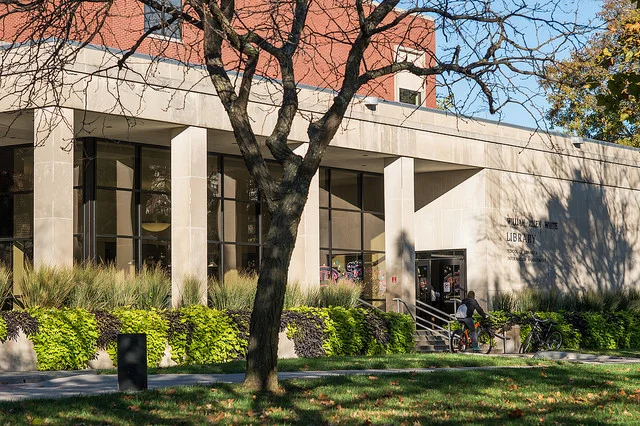
Image of the front of the William Allen White building.
Work Cited
Emporia State University Libraries and Archives. Special Collections and Archives. n.d. Web. Retrieved 24 June 2014.
Emporia State University. Former Presidents of Emporia State University. n.d. Web. Retrieved 23 June 2014.
Hodowanec, George V. William Allen White Library Annual Report 1980-81. TS. Emporia State University Special Collections and Archives.
---. William Allen White Library Summary of FY82 Annual Report. 23 June 1982. TS. Emporia State University Special Collections and Archives.
Mason, John A. “The William Allen White Library, 1966-1974.” Graduate research project. Emporia Kansas State College, 1974. Print.
Rich, Everett, comp. William Allen White 1868-1968: A Memorial to a Great American. 2nd ed. Kansas State Teachers College of Emporia: Teachers College Press, n.d.
Stephens, Harold H. “A Study of the Growth and Development of the Library of Kansas State Teachers College, Emporia, 1865-1930.” MS thesis. Kansas State Teachers College, Emporia, 1935. Print.
Williams, Marjorie G. “The William Allen White Memorial Library of Kansas State Teachers College, Emporia, 1930-1959. “ MS thesis. Kansas State Teachers College, Emporia, 1959. Print.
Images from the Walter M. Anderson Collection | Emporia State University Special Collections & Archives.
History Essay written by Cynthia Kane and Steven Hanschu.
